The Ultimate Life Science Marketing Guide
Industry leading insights and case studies from working with 150+ life science companies, written by 3 PhD Scientists

Megan Waldman, Ph.D.
Director - Content Strategy

- What is Life Science Marketing?
- Key Elements of a Successful Life Science Marketing Strategy
- Where Effective Life Science Marketing Begins
- Understanding Your Target Audience and Ideal Customer
- Developing Buyer Personas for Effective Targeting
- Branding and Positioning in the Life Science Industry
- Creating a Strong Online Presence through Website Optimization and SEO
- Web Design and User Experience (UX) for Life Science Websites
- Quality Web Development for Life Science Companies
- Successful Scaling with Paid Advertising
- Utilizing Social Media Platforms for Effective Outreach
- Email Marketing, Automation and Lead Nurturing in the Life Science Sector
- Leveraging Data Analytics and Conversion Tracking Tools
- Life Science Public Relations: The Key to Building Trust and Credibility in a Specialized Field
- Case Studies of Successful Life Science Marketing Campaigns
- Next Steps
- Meet The Authors
- Life Science Marketing FAQs
Introduction
Life science marketing, much like the vast field of study it supports, is intricate and complex. Remember viewing a cell under a microscope for the very first time? For something that seemed so deceptively small, the closer you looked, a lot of detail was packed into that tiny oval. Then you zoomed in even further and began to see how all the various parts worked together to accomplish their intended purpose.
There are many "organelles", if you will, that go into an effective life science marketing strategy. We've asked our own team of Ph.D.-level experts and marketing professionals to zoom in on, and share, some of their favorite tips for you to apply at your own company.
What You Can Expect In This Article
The observations and tips compiled below come with decades of combined experience marketing for life science, biotech, and healthcare companies around the world. Included are direct quotes from our seasoned executives and team leads, many of whom are PhDs themselves in a related field of study. If you are interested in jumping quickly to a particular section, please use the dropdown bar labeled 'Table of Contents' at your convenience.
Whether you are brand new to marketing in the life sciences, or you've been doing it the world over for more than a decade like us, we hope you get a lot of value out of the hard-won insights we have to share with you.
What is Life Science Marketing?
At Supreme Optimization, our broad definition of life science marketing is one of a specialized field that promotes products, services, and research in biotechnology, pharmaceuticals, and healthcare. Unlike generalized marketing, life science requires industry-specific knowledge including a nuanced understanding of scientific terms, complex regulatory environments, and the unique needs of various stakeholders ranging from researchers to clinicians.
Market Trends and Challenges in Life Science Marketing
As the industry continues to evolve, your marketing strategy needs to evolve as well to keep ahead of the competition. That said, it is no secret the life science industry is undergoing a rapid digital transformation due to technological advancements. To gain a "slight edge" over rivals, companies are increasingly adopting technologies like advanced data analytics, AI, and machine learning into their workflows to enhance innovation, efficiency and productivity.
This digital shift also brings its own set of challenges, including the need for specialized talent and infrastructure to capitalize on these new abilities. Guarding against threats of cyber attacks is also a growing concern. With life science companies gathering and storing sensitive, proprietary data, the need for robust cybersecurity presents its own set of unique challenges that will need to be collectively addressed in the near term.
Artificial Intelligence
 What about AI? How is it influencing the Life Sciences?
What about AI? How is it influencing the Life Sciences?
Supreme Optimization's founder and President, Sheldon Zhai, is also our Head of Artificial Intelligence. On the topic of how AI is changing the industry on the ground level, he says:
"Artificial intelligence is changing life science as we know it in some really exciting, yet challenging ways. For example, leaning more into these technologies means that there is growing demand for specialized roles like data scientists and AI specialists. This increasing talent gap presents a real challenge for business leaders. Companies are faced with a choice; they must either work fast to upskill their existing workforce or compete for limited, specialized talent. To do neither, or to react too slowly, means you risk losing market share and getting left behind as these technologies develop and we discover further utility."
Of course, this is just a quick snapshot for your consideration. Understanding these trends and challenges is crucial for life science companies to navigate the evolving landscape and develop targeted marketing strategies effectively.
To read more about life science marketing trends, check out our latest report, here.
Key Elements of a Successful Life Science Marketing Strategy
Where Effective Life Science Marketing Begins
We all know that life science, biotechnology and healthcare are highly specialized fields. If you've ever hired or worked with a "one-size-fits-all" marketing agency, then you'll also know that their efforts often fall frustratingly short without this same industry-specific knowledge and expertise. In our experience as a solely dedicated life science marketing agency, this highlights the necessity for life science companies to work with marketing teams that also have deep knowledge in these areas.
Understanding Your Target Audience and Ideal Customer
 Knowledge can only get one so far though. Successful marketing in life science also requires a deep understanding of the product or service being sold in order to be truly effective. Megan Waldman, PhD., Supreme's Director of Content Strategy emphasizes the importance of understanding your audience and their specific needs.
Knowledge can only get one so far though. Successful marketing in life science also requires a deep understanding of the product or service being sold in order to be truly effective. Megan Waldman, PhD., Supreme's Director of Content Strategy emphasizes the importance of understanding your audience and their specific needs.
She says "Effective marketing in the life sciences involves not only understanding who you're marketing to and their buyer's journey, but also delivering educational and thought-leadership content to reinforce the prospect's confidence throughout that cycle."
In other words, generic marketing typically gets generic results.
Life science companies need a marketing team and/or agency that not only understands the science behind the offer, but also the nuances of a scientific audience and the competitive landscape.
For instance, let's say you need to hire someone to do genetic sequencing. Would you do so based on their sole ability to piece together complex jigsaw puzzles? It's true, both activities require careful analysis, attention to detail, and an understanding of how each small component contributes to the larger whole, but that's about where the similarities end.
Megan goes on to say:
"If you are in this field, then you know the buying process is highly informed and evidence-based. As such, the sales cycle can be lengthy. Therefore, the marketing strategy must be equally informed and strategic, with a focus on the long-term. If you are attempting to outsource your marketing to a team that does not have a deep knowledge and understanding of what you do, and who your ideal customer is, your prospect will see right through that inauthenticity and your marketing results will reflect it," she says.
Developing Buyer Personas for Effective Targeting
As we've stated, creating detailed buyer personas can help in tailoring your marketing strategies to best reach your target audience. Buyer personas are semi-fictional representations of your ideal customers, based on market research and real data about your existing customers. Over the years Supreme has fine-tuned our own process for developing buyer personas and effectively targeting them. Waldman offers this piece of advice for anyone looking to fine-tune their target audience:
Without the above considerations, it is likely your content efforts and overall message will not reach or resonate with your intended audience and therefore fall short of expectations. Having clearly defined personas allows your business to maintain a consistent message that can scale across marketing efforts as your team evolves and grows with time.
If you get one takeaway from this section, let it be this - Don't skip the critical step of identifying your company's buyer personas!
"The most critical consideration when targeting audiences within the life sciences is making your unique value to the customer very clear, accessible, and consistent.
To do this, you need a thoughtful positioning statement, messaging strategy, and an intimate understanding of your best-fit prospect. A critical step to targeting audiences is documenting their needs, challenges, goals, daily life and workflow, how they prefer to digest content, who their key influencers are, and what are their barriers to purchase.
Then you have to ask yourself, what kind of questions are they asking to find information and what media platforms and social networks are they on? What is going on around them to really make them care about your solution?"

Know Your Customer's Journey
Having a deep knowledge and understanding of your ideal customer and the path they take can help you strategically address their specific needs at each stage. This is known as the "Customer Journey," This ensures your marketing intentionally guides them toward the solution they need, wherever they're at, at just the right time.
The graphic below is an example illustration we use at Supreme to help map the customer journey for clients. Each stage has specific, prescribed touch points along the way. These are designed to advance them further down the funnel with the goal being an initial sale and subsequent, repeat business.

Supreme Optimization:
A World Leading Life Science Marketing Agency
This is one of the many reasons Supreme Optimization has been, and continues to be, a leading life science marketing agency.
We have life science encoded in our DNA.
Our in-house team of over 100 includes 50+ Ph.D.-level scientific marketing strategists. Together, our team has successfully launched and maintained hundreds of life science, biotechnology and healthcare campaigns and websites. We take great pride in bringing a best-in-class life science digital marketing experience to your business.
Knowing your audience is "Marketing 101," but in the life sciences, it's not so straightforward all the time. Are you targeting hospital procurement managers, lab researchers, clinical trial patients, and clinicians? Each requires a different approach and messaging strategy.
This next section will help you position your company's brand for success.
Branding and Positioning in the Life Science Industry
 "Your brand is more than just a logo; it's what people think of when they hear your name," says Michelle Maile, Supreme's Scientific Content Strategist. "In the life science industry, trust and credibility are paramount. Therefore, your branding should focus on positioning and establishing you as a reliable, expert-led solution provider."
"Your brand is more than just a logo; it's what people think of when they hear your name," says Michelle Maile, Supreme's Scientific Content Strategist. "In the life science industry, trust and credibility are paramount. Therefore, your branding should focus on positioning and establishing you as a reliable, expert-led solution provider."
Crafting a Unique Brand Identity
Michelle is quick to emphasize the importance of companies creating a unique identity for themselves:
"In a crowded, ultra-competitive sector such as life science, it is critical to differentiate from, and position your business ahead of, the competition. Your brand needs to set you apart from the rest," she says.
Maile advocates doing this by crafting a narrative that highlights the mission, point of view, and impact of a company's innovations, custom-tailoring these to the specific audience's interests.
Brand Differentiation & Positioning
Michelle also says that there is often confusion on the distinctions between differentiation and positioning and how they can work together to create a solid brand. So to help clear this up, she shares this quick breakdown:
Differentiation is achieved by standing out with a unique brand identity. Successful brands are easily identifiable and leave a lasting impression on their target audience.
Positioning:
• Clarifies your target market
• Sets your company apart from competitors
• Guides your marketing strategy
• Influences your customer perception
• Supports premium pricing
• Facilitates brand recognition
• Drives product development
• Enhances customer loyalty
Now imagine you are at a bustling conference full of life science experts and innovators. Everyone is vying for attention. Your company's voice is just one among many in this space. Differentiation is what makes your voice unique. But being unique isn't enough if nobody can hear you, or if your message doesn't resonate with the audience. That's where positioning comes in. Continuing with this analogy, Michelle describes positioning as “...the strategy you use to navigate through the crowd, get yourself next to your ideal customers, and ensure that when you speak, you're not only heard, but also making a memorable connection.”
Positioning in life sciences involves finding the right context for your offer; one that makes its value immediately apparent to the prospects who regard it the most. It's about framing your solution in a way that leverages your offer’s strengths (the strengths that the prospect cares about) and resonates with the specific pains of your target customers.
Michelle adds, “When you position your product effectively, you're essentially saying, 'Hey, I understand the unique complexities of your scientific challenges. My offer is uniquely equipped to solve this problem for you'.”

Megan Waldman, whom we heard from earlier, also wants to emphasize that differentiation and positioning are not merely marketing exercises; they are foundational elements of your business strategy that inform how you build, sell, and grow your products and services in the market:
“Differentiated positioning is arguably the most important building block of successful marketing,” Megan continues. “It's the foundation for all messaging across the organization. The foundation for site architecture, brand identity, every piece of content, slide deck, and pitch that an organization creates. Without differentiated and future-proofed positioning, organizations risk diluting their value proposition, confusing their best-fit prospects, and ultimately losing opportunity for won deals. Nobody wants that!”
What big names come to mind when you think of “life science?” What makes them unique and memorable?
These companies understand and have mastered both elements of differentiation and positioning. What can you learn from them to apply to our own brand?
To see how a world-class life science marketing agency helps brands research, identify, position and differentiate themselves as industry leaders, view these in-depth case studies.
Creating a Strong Online Presence through Website Optimization and SEO
In today’s digital age, branding and websites go hand-in-hand. Your online presence can either help or hinder your success, with your website often being the first point of contact between you and your customers.
Have you ever gone window shopping while out in the real world?
Picture the stores you are naturally drawn into. Just like a well-designed storefront can attract customers in from the sidewalk, a well-designed website can make a positive first impression. And once a prospect is inside, a pleasant experience encourages them to stay longer and explore what you have to offer, dramatically increasing your chances of making a sale.
 According to Supreme’s Director of Digital Strategy, Lauren Whitehead Ph.D.:
According to Supreme’s Director of Digital Strategy, Lauren Whitehead Ph.D.:
“Customers are a lot less patient with poorly designed and functioning websites now than they were just a few years ago. Your website needs to be easy to navigate, with clear and concise information that is easy to find. It should be fast to load, as no one wants to browse a slow website. It should also be optimized for search engines like Google, so that potential customers can easily find it when they are looking for products or services like yours.”
Whitehead continues, "Search Engine Optimization (SEO) is a necessity for any serious life science company. It helps connect customers with companies that can provide products or services to move their research forward.” She highlights the importance of visibility, especially for researchers unaware of specific products that could aid their experiments.
When asked for some needle-moving tips for creating a website that will impress your customers, Lauren recommends the following best practices:
5 SEO Elements You Must Incorporate Into Your Website
- 5 SEO Elements You Must Incorporate Into Your Website
- Use custom, high-quality images and videos.
- Write clear and concise copy appropriate for your audience.
- Make sure your website is mobile-friendly (Even if a majority of your traffic is from desktop traffic, Google ranks your site based primarily on how your site performs on mobile).
- Offer unique, valuable content such as blog posts, free reports, or infographics.
- Collect customer feedback and use it to improve your website and visitor experience.
Life Science SEO Checklist
Life science SEO is an expansive and complex topic, one that requires much more time and attention than we have to give it here. Thankfully, Lauren and her brilliant team have written this excellent, comprehensive Life Science Marketer's Guide to SEO. Be sure to download your free copy to dive much deeper into how to optimize your website so that both humans and robots will love your site. (While you're at it, don't forget to take us up on your free website audit!)
To see real-life examples of how SEO can dramatically impact your life science business, Lauren recommends you check out the below case studies:
"Audubon Bio is a biospecimen company that had a very small website that was not being properly indexed by Google. We built a brand new site designed to capture pharma and biotech researchers looking for biospecimens," says Lauren. "They have had some incredible results considering they virtually started from zero and are now a real contender in the market."

“Another client, MP Biomedicals, didn’t know their website was blocking Google from crawling and indexing the site. We immediately fixed that setting and began work on improving page templates and product content. As a result, they have seen a massive increase in ecommerce revenue (+130%), 30% more web traffic and 150% more transactions.”
Web Design and User Experience (UX) for Life Science Websites
 As you can see from the above examples, the coordinated design and development of a website plays a pivotal role in the success and growth of today's life science company. Anthony Vendeirinho, Supreme's Director of Design and UX, offers valuable insights below about creating beautiful websites that convey credibility and expertise in this specialized field.
As you can see from the above examples, the coordinated design and development of a website plays a pivotal role in the success and growth of today's life science company. Anthony Vendeirinho, Supreme's Director of Design and UX, offers valuable insights below about creating beautiful websites that convey credibility and expertise in this specialized field.
Essential Website Design Elements for Credibility
What are the essential design elements for a life science website to ensure it conveys credibility and expertise?
According to Vendeirinho, "The structure of the website needs to be well-organized based on the target needs along with a good balance of colors and imagery."
He stresses the importance of original imagery, suggesting, "In our experience, stock photography underperforms custom images. Proudly display your company's scientists, dressed in lab coats complete with company logo. This conveys more credibility and confidence than using generic stock photos."
Much like Megan Waldman and Michelle Maile stated earlier, Vendeirinho also highlights the significance of visually distinctive branding; "A website with top-notch design, a pleasing color palette, original imagery, and unique micro-animations, will stand out in comparison to the competition. It's often the little details you don't think anyone else will notice that leaves the biggest impression," he says.
Improving UX for Complex Information Access
Life science websites can be a huge challenge for companies to get right due to their depth and complexity. Addressing the challenge of presenting complex information, Vendeirinho advises:
"The first step is to understand the target audience and what the users are searching for. You can then create comprehensive site architecture, complete with sub-pages, to facilitate a logical flow that ensures you guide the user to what they are looking for. For life science websites, this often involves categorizing navigation levels and creating sub-pages for each category."
Like we said, it's complicated! For someone like Anthony though who has designed hundreds of life science websites, this is all second nature. This is yet another benefit of working with seasoned, life science professionals.

Key Features for Effective Web Development
So what should you focus on when looking to build and design an effective site that your visitors can efficiently navigate and use effectively?
When developing life science websites, Vendeirinho recommends focusing on design functionality across devices, content-design balance, and backend editability:
"The capability to edit or add new content in the backend of the website without requiring assistance from a development team is of utmost importance. You want to be able to make those edits quickly to keep your site up-to-date. Relying on a third party to make those changes on a regular basis can really slow down production and overall efficiency. This industry is only accelerating from what I've seen. Make sure your website and the team responsible for it can keep up."

Challenges and Solutions in Life Science Web Design
Specific to life science web design, Vendeirinho identifies several common challenges.
"[When viewing life science-related websites] it's not out of the ordinary to encounter a lack of custom images, low-quality charts and graphics, and outdated or non-existent brand guidelines," he says. He suggests solutions like conducting in-house photo shoots, recreating and updating graphics to align with the website's style, and establishing standard brand guides to maintain a consistent look and feel.
Examples of Effective Web Design and UX
Highlighting the impact of great web design, Anthony recommends taking a look at the AudubonBio case study. In addition to the SEO enhancements mentioned above, he credits the new website design with significantly increasing lead generation efforts.
A few others that come to his mind are Nilogen and DWK, where interactive elements and filters are utilized to improve user experience (UX). Click the links above to take a closer look at any of these case studies.
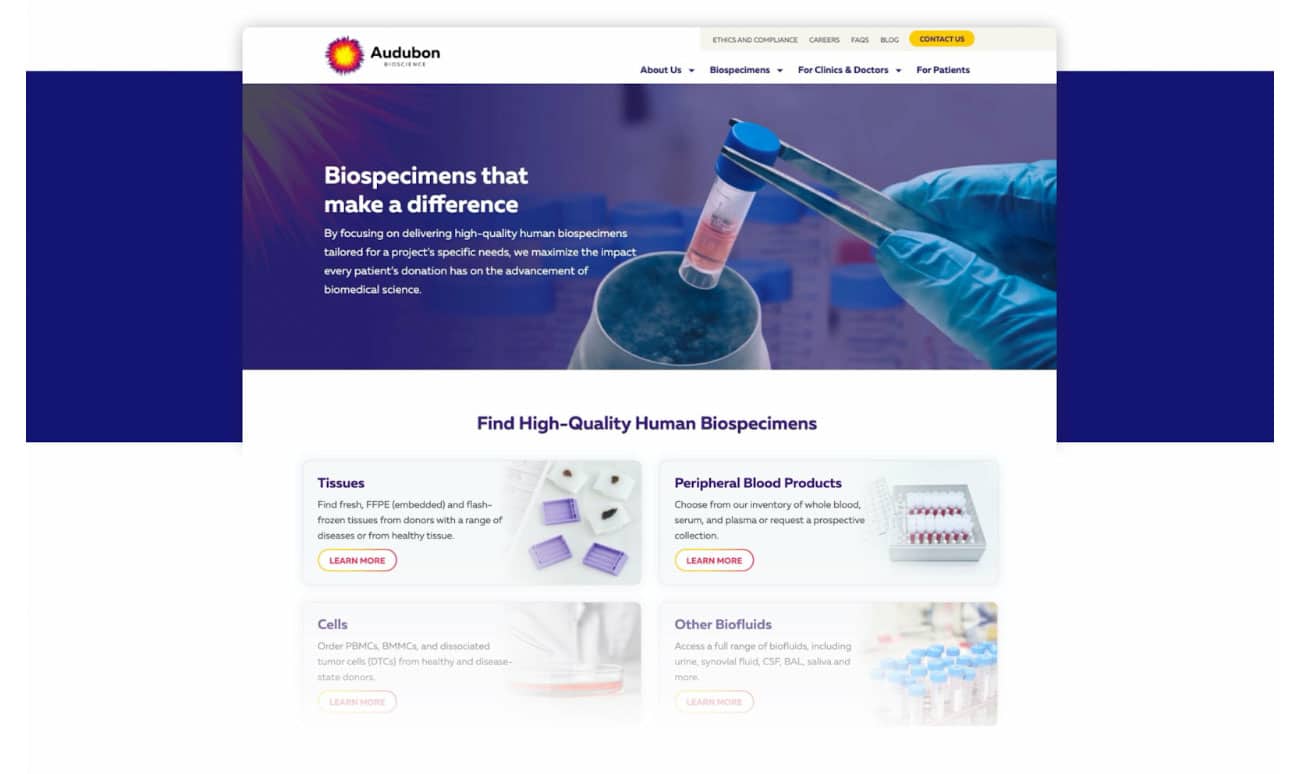
Quality Web Development for Life Science Companies
Vendeirinho is also quick to credit his team for the client website successes highlighted above. As Supreme's Director of Web Development, Erik M. Barrett has overseen nearly 100 large and complex web development projects.
"A website is not merely a digital brochure but also a highly functional, customized, and engaging platform that communicates your mission, showcases your solutions, and serves as your primary sales tool," he says.
To illustrate this point, Eriks points to the graphic below taken directly from our website. This checklist highlights just some of the various elements that should be considered when designing and building a website.

Common Life Science Web Development Issues and Solutions
 Barrett notes several common web development issues life science companies encounter:
Barrett notes several common web development issues life science companies encounter:
"Ease of use, scalability, site speed, performance, poor search functionality, and inadequate UX/UI design are all challenges facing life science companies that come to us asking for help. These can significantly impact the effectiveness of a website as a business tool."
To address these concerns, Barrett highly recommends utilizing robust yet user-friendly platforms like WordPress, Magento, and BigCommerce.
Like Vendeirinho, Erik also points to the importance of clients being able to easily make site edits and updates in-house. "One of the common issues we hear from new clients is that their existing website makes it difficult to make edits or updates as needed. WordPress as your CMS, along with our own custom page builders, remedies this common problem." Barrett explains.

Advantages of Specialized Platforms
Having tried numerous ecommerce platforms, Barrett praises the strengths of Magento and BigCommerce, particularly for B2B ecommerce solutions in the life sciences industry. These platforms are known for their ability to scale to enterprise levels while maintaining peak performance and still allowing for complex customizations.
Barret adds, "As a partner agency for both platforms, we have found BigCommerce and Magento great to work with. Best of all, our clients absolutely love the results."

Tailoring Web Development to Life Science Needs
These insights again underscore the need for a web development approach that is tailored to the unique requirements of the life science industry. This includes not just aesthetically pleasing design, but also functionalities that enhance the user experience, improve product and service discoverability, and seamlessly integrate with other essential business systems.

Successful Scaling with Paid Advertising
Okay, so let's say you have made all the necessary adjustments to your marketing and design strategy up to this point. Now that your site is firing on all cylinders and you have customers engaging with you and buying what you're selling, how can you best multiply those efforts?
Paid advertising is the surefire way to help you scale your efforts more quickly.
Platforms like Google Ads and LinkedIn Ads offer advanced targeting options, allowing you to reach the right people at the right time.
This brings us to a point of caution…
If you are currently searching for a life science marketing agency to handle your ad accounts, make sure they have a relevant and strong, proven history in creating and managing effective ad campaigns that deliver measurable results in your niche!
Here's why…
Google Ads PPC
Pay-per-click advertising (PPC) such as Google Ads can be a powerful tool for life science companies looking to attract targeted traffic quickly. You only pay when someone clicks on your ad, making it a cost-effective option when done properly. Google Ads also allows for keyword targeting, enabling you to reach potential customers who are actively searching for products or services like yours.
 We asked Mihaela Pupavac, PhD, Supreme's Director of Paid Search, what is one of the most common errors that she and her team sees when auditing a new client's ad account. Here is what she had to share:
We asked Mihaela Pupavac, PhD, Supreme's Director of Paid Search, what is one of the most common errors that she and her team sees when auditing a new client's ad account. Here is what she had to share:
"A common mistake we see advertisers without life science research experience make when advertising life science products is that they have never interacted with the products they are advertising.
Therefore, they cannot gauge the intent of various keywords they find by looking at the client's website or using keyword research tools.
As a result, they end up targeting long lists of related keywords, synonyms, and application keywords in the hopes of covering everything. But that just leads to poor conversions due to misdirected, and ultimately wasted ad spend. More is not always better. You don't need to target all of the keywords - you just need to target the right ones," she says.

To illustrate the pitfalls of oversight for us, Mihaela provides this true-to-life account:
For example, look at this client's ad campaign, prior to working with Supreme. This was for a reagent restocking service. If you've ever worked at a research institute, you likely would have used what's commonly known as a "bio-bar." Bio-bars are freezers filled with most common reagents used in the lab, so that if you run out of something mid-experiment, you can grab the reagent from the freezer without waiting for your online order to come in. Most large life-science companies offer this service to many institutions globally.
Because the landing page for this service had images of freezers, and freezers were mentioned in the text, the Account Manager setting up the Google Ads campaign made some incorrect assumptions. Having no concept of what this service could possibly be, they wrongly assumed that the company was selling freezers, which led to tens of thousands of dollars of wasted ad spend over the course of a year.
The Secret Sauce of Targeting the Right People with the Right Keywords
This example, of course, is less than ideal, but more common of an occurrence than one would hope. Pupavac goes on to add, "To target the right keywords, advertisers should:
- Already have extensive knowledge of, or the ability to thoroughly research, the life science industry and the products they are advertising.
- Understand the true intent of potential customers.
- Use keyword research tools to identify relevant keywords.
- Create a targeted keyword list and ad campaigns based on the desired intent.
Having a deep understanding of your target audience, the Google Ads platform, and the life science industry is all part of the secret sauce of being able to create winning Google Search Ad campaigns that drive large numbers of conversions and beat out the competition."
Supreme Optimization's distinctive expertise in life science and Google Ads management ensures that client campaigns are optimized for the highest return on investment. From keyword selection to ad copy and landing page design, we know what it takes to get the most out of your ad budget.

For a really DEEP dive into Google Ads for Life Science, check out our Complete Guide to Google Ads.
Why LinkedIn Ads for Life Science and Biotechnology?
 In addition to Google Ads, LinkedIn Ads are particularly effective for B2B marketing in the life science sector. We asked Ben Duffield, our Director of Paid Social why his clients love LinkedIn Ads and here is what he says:
In addition to Google Ads, LinkedIn Ads are particularly effective for B2B marketing in the life science sector. We asked Ben Duffield, our Director of Paid Social why his clients love LinkedIn Ads and here is what he says:
"The platform offers unique targeting capabilities you can't find elsewhere, such as job title, company size, and industry. This allows us to reach ultimate decision-makers directly. We can get the exact eyeballs we want using Sponsored Content, Sponsored InMail, and Display Ads. Our clients really appreciate the enhanced ad performance and ROI that Linkedin offers."
While the overall popularity of LinkedIn has ebbed and flowed over the years, it has become one of the primary online life science communities. Over 5,000,000 scientists and researchers use LinkedIn to share scientific research and proudly display their publications.

LinkedIn Has the Most Powerful Targeting for Researchers
Unlike other social platforms, LinkedIn specifically allows people to showcase their resumes, work experience, and professional skills. Here's a look at another one of our Ph.D.'s LinkedIn profiles.
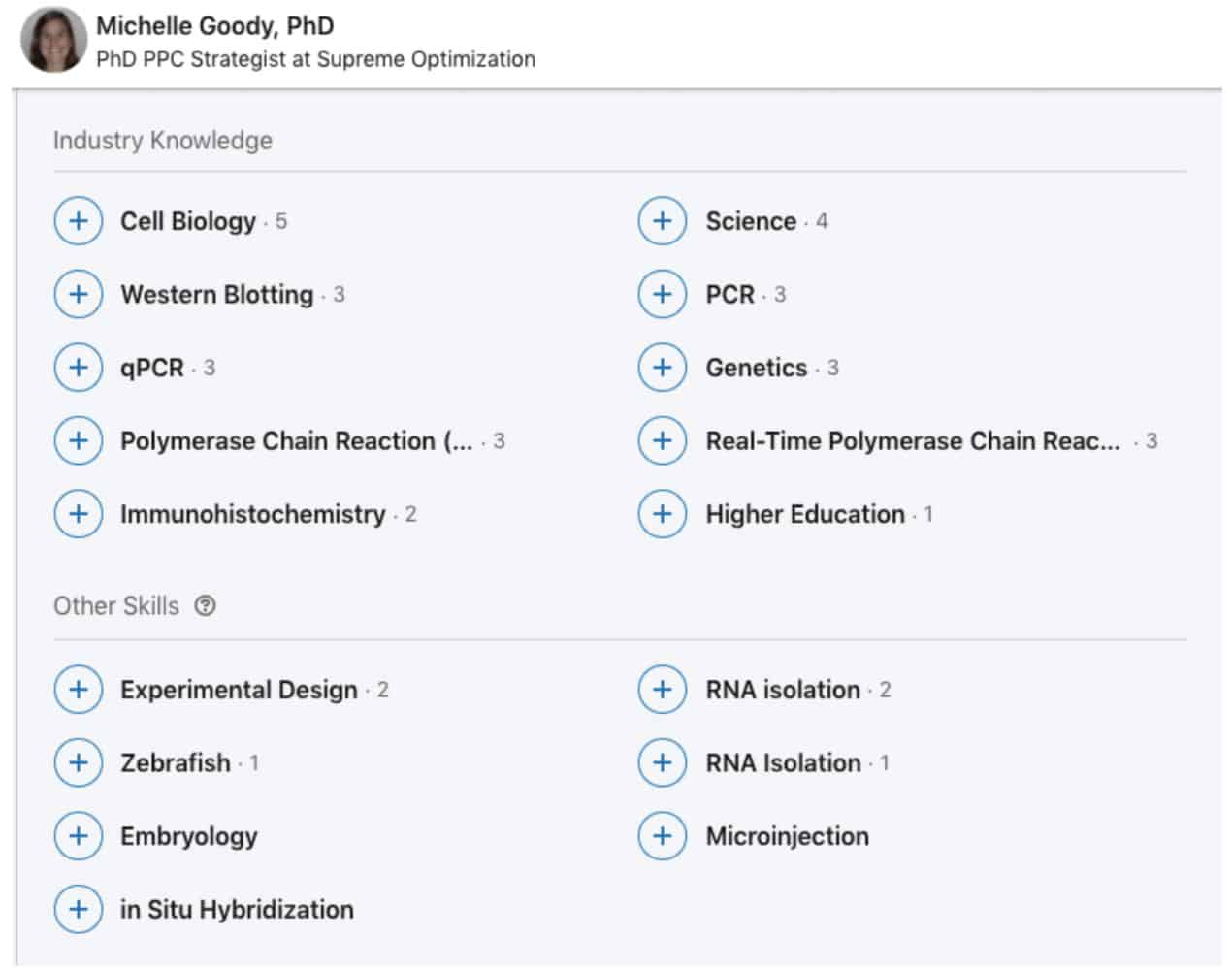
On the LinkedIn Ads platform, you are able to target audiences with these specific professional skills, allowing you to reach the exact audience, in this case researchers, that use specific life science products.
Ben adds, "No other platform offers this kind of specificity for targeting except perhaps ResearchGate. That said, we have found that scientists and researchers aren't nearly as active on that platform and they don't keep their profiles as up-to-date. This has made LinkedIn Ads our primary advertising platform for scaling life science companies along with Google Ads."

What is the Best Offer on LinkedIn Ads?
Thankfully, almost every life science company already has some promotional scientific material that can be used as collateral for lead generation campaigns.
Duffield says, "The key is to be mindful of the offer you choose. WE have found that PDF downloads of whitepapers, application notes, case studies, brochures, and on-demand webinars hit the sweet spot in terms of conversion rate and perceived value with many cold audiences on LinkedIn."

"The key is to use a piece of collateral from within the "sweet spot" in combination with LinkedIn lead generation forms," Ben says.
"These are forms that open on the LinkedIn platform when a user clicks an ad on their news feed. The advantage of these native forms is that the fields are automatically populated with the user's profile information, further reducing friction and increasing the conversion rate 5x compared to conventional landing pages."
As an example, Supreme has several offers that we give out freely in exchange for a prospect's name and email address, one of them being our comprehensive guide on LinkedIn Ads.
To see how you can hit the sweet spot using LinkedIn Ads effectively for your life science business, view our free, comprehensive LinkedIn Ads guide.
The Ongoing Trend: LinkedIn is Becoming More Expensive $$$
Ben goes on to add, "It's important to note that from 2019 to 2023, we have seen the average cost per lead for life science companies rise from $30-$80 to $80-$150. When industry awareness increases, LinkedIn will inevitably become more competitive. As marketers flock to take advantage of its powerful features, it will be more important than ever to get the best results for the investment and to do it sooner than later."
Use a Full Funnel Campaign with Excellent Content
This reality has led to the need for more innovative and complex marketing and advertising strategies on LinkedIn. We have seen from our own internal data that it takes several touchpoints before life science researchers make a meaningful conversion.
"Like other popular ad platforms, it is not just going to be a single ad with one offer that is going to convert these researchers into qualified leads," Duffield continues.
As a result, the LinkedIn Ad platform has responded by considerably improving its remarketing tools.
"In addition to remarketing to website visitors, we now have the ability to remarket to users who have watched videos on LinkedIn, viewed the LinkedIn company page, or engaged with any of our ads. These tools give us the capability to lead prospects down the marketing funnel with multiple touchpoints [that are needed to convert them], all within the LinkedIn platform."
This needs to be done with the right types of content at different stages of the funnel. Here is the funnel strategy Ben implements for Supreme and our clients:

Ready to realize the full potential of LinkedIn Ads? Download a free copy of our comprehensive guide.
Social media isn't just for B2C companies (or friends posting photos of what they ate for lunch). Depending on your product or service, it can also be an effective channel for B2B marketing in the life sciences. As we're sure you've seen, when used properly and with intention, social media can be particularly useful for connecting with other businesses and professionals in your industry.
You may be saying to yourself, "But my organic post reach has only become smaller and smaller over the years. What's the point?"

It is true that social media is not as reliable as it once was at organically reaching a large audience. However, there are still effective ways to use social media to reach your target audience despite its limitations of which Ben describes below:
While building an organic following and reaching your target audience can take a considerable amount of time and effort, Ben says "Sponsored posts ads can instantly increase the reach of your organic posts. Unlike organic posts themselves, these posts can be targeted to specific audiences. This way you can make sure that your message is seen by the people you want to reach."
Another underutilized benefit of sponsored ads is the reporting component. Ad performance can be tracked to a very granular level, so you can see how well your posts are resonating with your audience and make adjustments to your social content strategy as needed.
How to Use Sponsored Ads For Life Science Companies
Here are some of Ben's quick tips for using sponsored ads to increase the reach of your organic posts:
- Strategically target your sponsored ads to specific audiences based on your ideal customer.
- Use relevant keywords and ad copy.
- Track your results and make adjustments as needed.
- Use custom, high-quality images and videos.
- Test different ad formats to see what works best for you.
- Be patient and consistent with your campaigns.
If you've spent a lot of time and resources in years past building your social media platforms only to have your organic reach diminished, sponsored ads can be a great way to salvage those efforts while reaching a larger audience and growing your industry influence.
Email Marketing, Automation and Lead Nurturing in the Life Science Sector
You've got mail! While some life science companies attempt to navigate how to get the most out of their social media accounts, email marketing remains one of the most effective and consistent channels for lead nurturing and customer retention. The fact that you can automate what emails are sent and when makes it even better.
Email allows you to keep your audience engaged, nurture leads through the sales funnel, and provide timely updates and information to further build brand authority and trust with your audience.
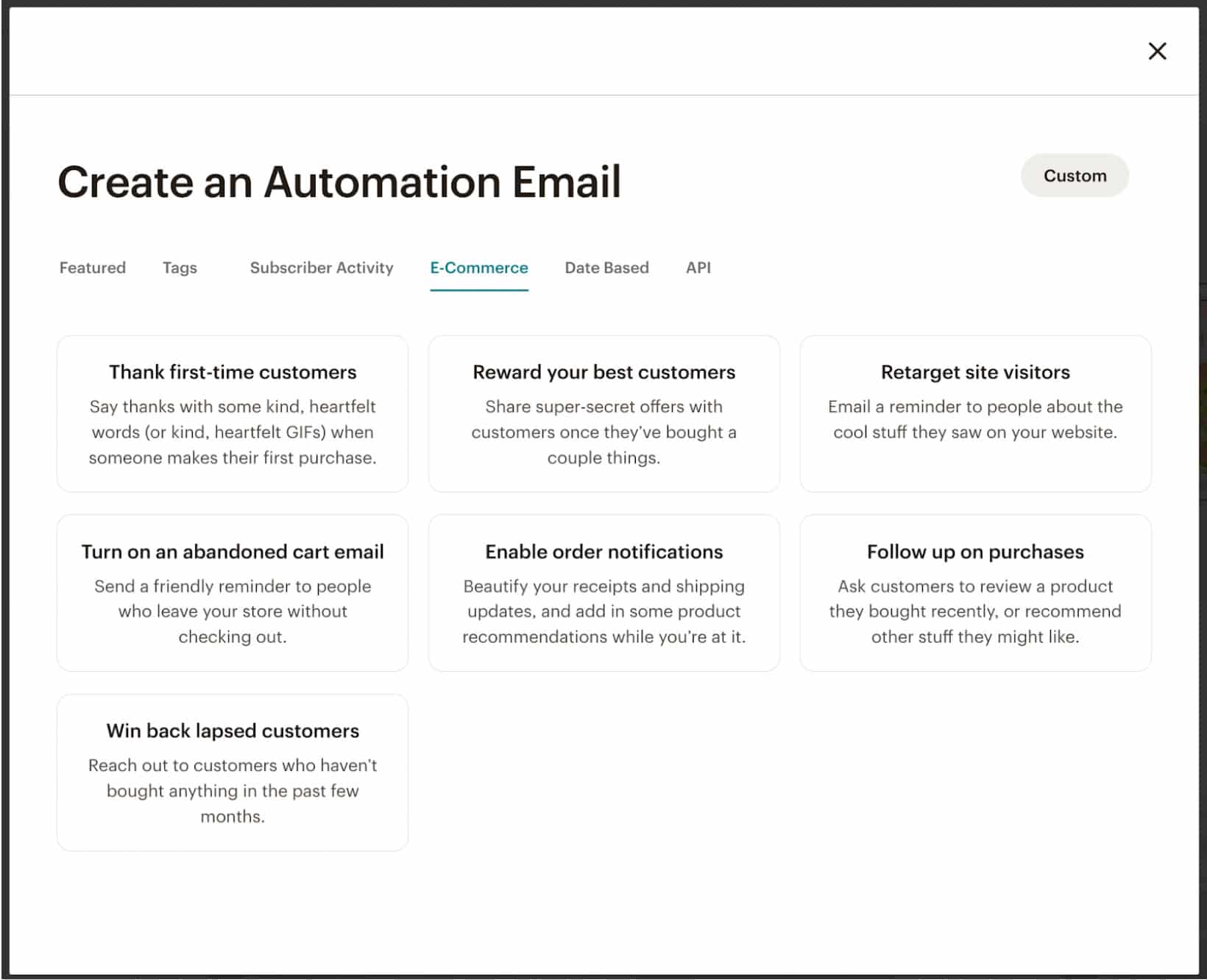
Eric Southwell, Supreme's Chief Marketing Officer, has this to say about why he encourages his clients to have a robust email strategy:
"While I love Google Ads and LinkedIn Ads, they are only part of a complex equation for a successful life science marketing strategy. Email marketing allows us to send highly targeted messaging, ensuring that information is tailored to the specific interests and needs of each recipient. For us, in terms of ROI, email continues to be a top performer. When done right, it is an indispensable tool to help position and grow life science companies," he says.
If you have yet to take full advantage of the benefits that email provides, Eric suggests getting started with a simple formula like the one pictured below:

Southwell goes on to say, "While great email marketing can also have short term payoff, the true investment is in the long term impact it can have for your business. Be authentic, helpful, provide tons of value, and you'll inevitably establish authority and build customer loyalty. More meaningful conversations, and the resulting sales of those conversations, is in part a by-product of sticking with a proven email strategy."
If you'd like to see value-driven email marketing in action, join over 2,500 life science professionals and sign up for Supreme's electronic newsletter.
Leveraging Data Analytics and Conversion Tracking Tools
Data analytics and conversion tracking can provide valuable insights into customer behavior, campaign performance, and more. These insights can inform your strategies, helping you make data-driven decisions that improve ROI.
In the dynamic world of life science marketing, understanding how to get the most out of these tools is essential. Jack Vernon, Supreme's Data Analytics and Tracking specialist in this field, provides valuable insights into their application and benefits for us below.
Common Challenges in Life Science Data Analytics
 "The biggest challenge I see clients struggling with when they come to me is defining what a conversion is and then tracking it across all the channels." Vernon then emphasizes and explains the importance of tracking, noting, "If you aren't tracking every key action on the website, then you are unable to see what part of your marketing mix is performing well and what is not." In other words, poor tracking leads to confusion and lackluster results.
"The biggest challenge I see clients struggling with when they come to me is defining what a conversion is and then tracking it across all the channels." Vernon then emphasizes and explains the importance of tracking, noting, "If you aren't tracking every key action on the website, then you are unable to see what part of your marketing mix is performing well and what is not." In other words, poor tracking leads to confusion and lackluster results.
To overcome these obstacles, Vernon advises, "Be sure to send events and conversions to analytical software such as Google Analytics (GA4). This way you can see what users are doing on your website and what percentage of users result in a conversion. Having this ability empowers you to make data-driven decisions that will set you up for success."
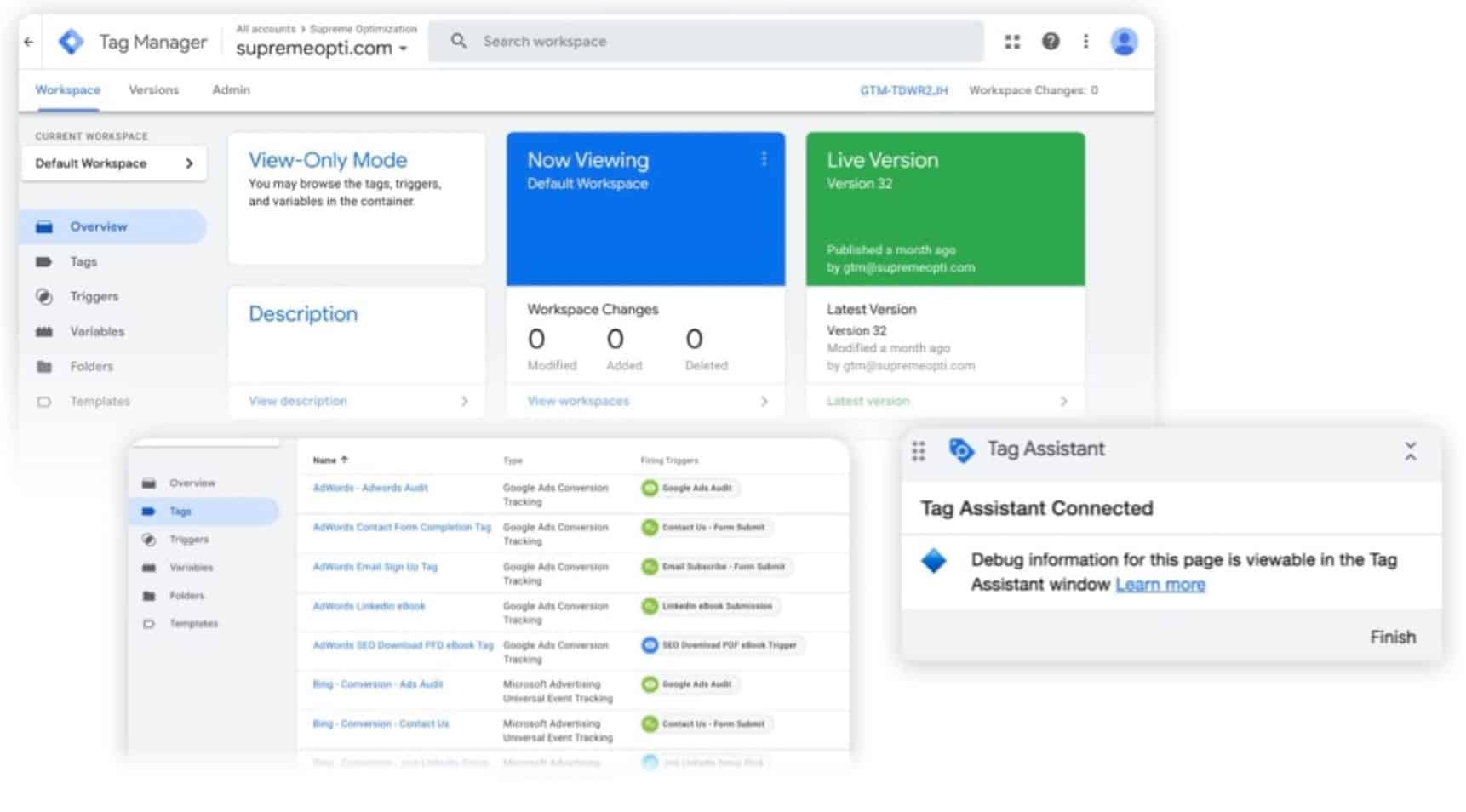
Harnessing Data for Strategic Marketing Decisions
While extremely technical, the strategic importance of data analytics in life science marketing can not be overstated. The necessity of not only collecting, but also intelligently interpreting data to make informed marketing decisions, helps steer life science companies toward achieving their marketing goals.
"At Supreme Optimization, we've leveraged tens of thousands of these data points compiled over the past decade to achieve a significant amount of successful marketing campaigns. This information is crucial for driving our data-driven marketing strategy and implementation, providing our clients with a distinct advantage in a competitive landscape," Jack says.

Life Science Public Relations: The Key to Building Trust and Credibility in a Specialized Field
Public relations for life sciences is a crucial, yet often misunderstood, element of a successful marketing strategy. It's not just about brand awareness. We see firsthand how PR is also instrumental in establishing industry credibility and fostering trust among your target audience. To further address the unique needs and challenges of this industry, Supreme Optimization recently acquired Clarity Quest, a leader in life science and biotech public relations (PR) services.
Clarity Quest (a Supreme agency) has already proven to be a stellar addition to the Supreme team. Its founder and Supreme's CCO, Christine Slocumb, MSEE, MBA has over 30 years of experience in marketing, business development, and product management across various companies. Her work experience spans fledgling start-ups to Fortune 50 corporations. She focuses her passion on marketing strategy and business planning in digital health, life sciences, and technology. She also currently holds eight US patents and is a member of the Forbes Agency Council.
Christine has recently written a book on the importance of strategic marketing and PR. She was kind enough to share some of the top PR insights she has gained over the years with us below:

Unique Challenges in Life Science PR
 Christine states that "PR for Life Sciences encompasses public relations for companies and organizations in the fields of biotechnology, pharmaceuticals, healthcare, and medical research. These industries present a distinct set of challenges due to the highly technical, regulated, and sensitive nature of their work. The importance of understanding these nuances is critical when navigating this arena."
Christine states that "PR for Life Sciences encompasses public relations for companies and organizations in the fields of biotechnology, pharmaceuticals, healthcare, and medical research. These industries present a distinct set of challenges due to the highly technical, regulated, and sensitive nature of their work. The importance of understanding these nuances is critical when navigating this arena."
She offers the following outline for your consideration should you be weighing the need for a life science PR firm to help you avoid common pitfalls.
- Technical Complexity:
Life sciences PR experts need to speak fluent biotech to get coverage in trade publications and translate complex science to mainstream business publications. - Regulatory Environment:
The life science sector is heavily regulated by government agencies such as the FDA (Food and Drug Administration) and EMA (European Medicines Agency). PR professionals must navigate strict compliance requirements and be well-versed in regulatory processes to ensure accurate and legal communication. The life science industry operates globally, with different regulatory requirements in various countries. PR professionals must navigate international regulations and tailor their strategies to different markets. - Long Development Cycles:
The development of pharmaceuticals and medical treatments can take many years and significant investments before reaching the market. PR professionals need to sustain interest and funding throughout these extended development cycles. - Sensitivity to Patient Advocacy:
Patients and patient advocacy groups have a significant influence in the life sciences. PR efforts must be sensitive to their needs, concerns, and interests, often involving close collaboration with these groups. - Targeting Diverse Audiences:
Life science PR often requires reaching diverse audiences, including healthcare professionals, patients, investors, policymakers, and the general public, each with their unique information needs and perspectives.
The Importance of PR in Life Sciences
Slocumb emphasizes the intrinsic and tangible value of PR in life sciences: "Third-party validation is priceless, and one way great PR agencies nurture this process is through earned media (not paid media)." Earned media, which includes publications, blogs, vlogs, podcasts, and industry-specific shows, is vital for creating impactful messaging, differentiating brands, and supporting awareness and lead generation.
She goes on to say, "Getting earned media coverage is part art, part science, and a lot of sweat. Like SEO rankings, it's a marathon, not a sprint. In PR, momentum takes time to build.
Great PR creates impactful, accurate, and validated third-party messaging that positions your executives and industry experts. It also separates your brand from the competition and communicates differentiation through earned media and other opportunities."
Using PR in tandem with your digital and content strategy supports ongoing awareness and lead generation. Good PR helps:
- Generate positive media coverage and enhance brand reputation.
- Engage diverse target audiences (prospects, investors, partners and new employees) and motivate them to take desired actions.
Consequences of Neglecting Life Science PR
On the opposite end, Christine emphasizes that neglecting PR in life sciences can lead to unfortunate missed opportunities:
- You miss getting the word out about your products and therapies to interested investors, partners, big pharma, etc.
- If your PR team is not knowledgeable as to regulatory requirements in each geographic area, you may unknowingly break a regulatory law.
There is often skepticism and scrutiny from the scientific community and the public regarding new medical breakthroughs. PR professionals need to build trust and credibility in an environment where claims can withstand rigorous scientific scrutiny. "One bad impression can last a lifetime!" - Don't do PR to stroke a leader's ego. Unless you have a famous CEO or one with a mind-blowing story and personality, stick to trades first.
Target trade publications before mainstream media. Getting into the trades will give you validation that will help you get into mainstream business publications. for raising awareness about products, therapies and potential regulatory breaches. Slocumb warns, "One bad impression can last a lifetime!" Since life science and biotech are specialized fields, she advises focusing on trade publications before mainstream media to quickly build validation and credibility within the scientific community.
Case Studies of Successful Life Science Marketing Campaigns
It's important to note that the effectiveness of the strategies mentioned above are not merely theoretical. To demonstrate this, below are real-world examples, including award-winning work that reinforces why.
The case studies that follow illustrate the transformative impact of well-executed marketing and PR campaigns in the life sciences sector, demonstrating how the two working in tandem can protect and elevate a business in this complex and evolving field.
To begin, take a look at Christine Slocumb and her team's work with Be The Match BioTherapies. Clarity Quest won a 2023 MarCom Platinum Award, exemplifying successful life science PR.
Another successful example is Norstella, which showcases how well-executed PR campaigns can significantly impact the life sciences sector.

To see how great PR can help protect and transform your business, click to learn more about our life science PR agency services.
To close, we'll highlight three other client success stories from Supreme Optimization's portfolio-DWK Life Sciences, MP Biomedicals, and Promega. Each case study showcases unique challenges and the tailored strategies employed to overcome them, providing a comprehensive understanding of effective life science marketing in action.
(For a more in-depth look at each case study please click the images below.)
DWK Case Study
DWK Life Sciences, a leader in labware, faced challenges in expanding its global reach. They partnered with Supreme Optimization to develop a comprehensive life science digital marketing strategy, which resulted in increased brand awareness and sales.
MP Biomedical Case Study
MP Biomedicals, a global leader in life science products, faced challenges in online visibility and customer engagement. With Supreme Optimization's help, they were able to implement effective SEO and content marketing strategies, driving significant improvements in web traffic and lead generation.
Promega Case Study
Promega, a leading provider of life science products, faced challenges in paid advertising. They turned to Supreme Optimization for a complete overhaul of their PPC campaigns, resulting in improved ROI and customer acquisition.
See more case studies of how a strategic life science marketing agency partner can drive measurable ROI and growth.
Next Steps
Congratulations on making it all the way to the end! As an industry professional, you are keenly aware that life science is complex and ever-changing. Likewise, as you just saw, life science marketing is not so simple either. That said, hopefully this article has helped demystify it for you. Your company's success doesn't have to rely on guesswork. Stick to the proven fundamentals while also adapting to new technologies and trends to stay competitive. We have plenty of resources to help you achieve your goals. Should you need assistance, Supreme Optimization, with over 100 team members and 50+ Ph.D.-level experts, stands ready to help you navigate these challenges. Contact us to get the conversation started.






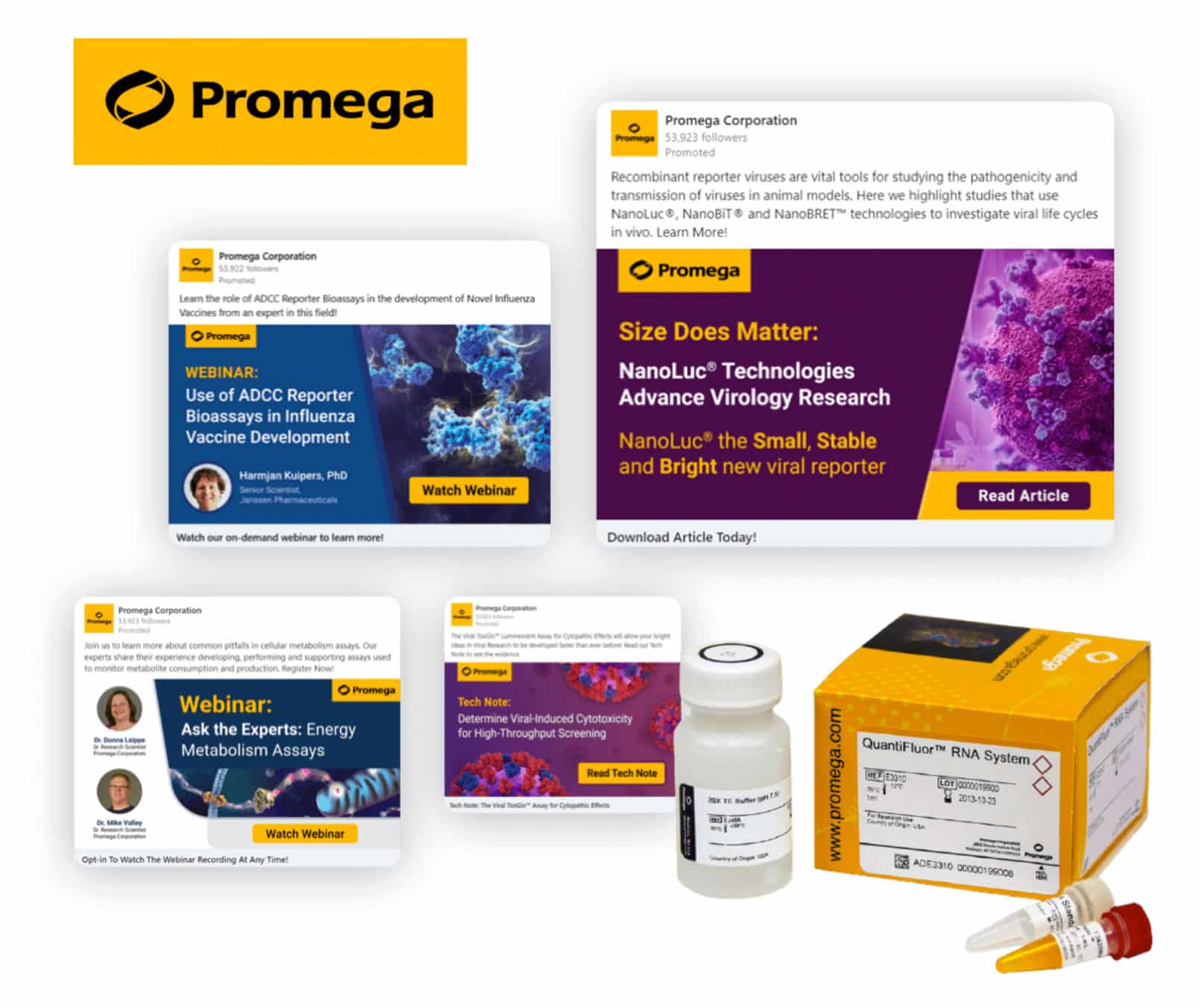









Utilizing Social Media Platforms for Effective Outreach